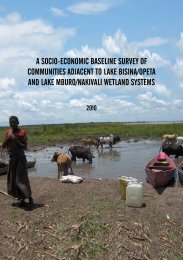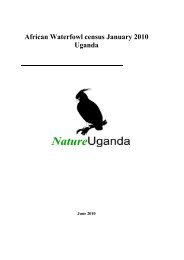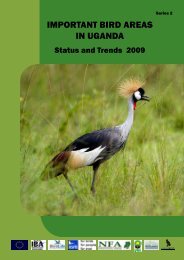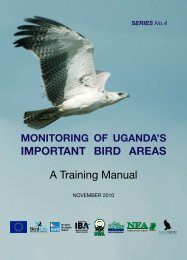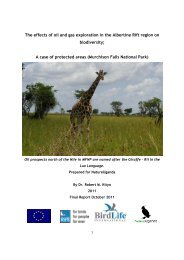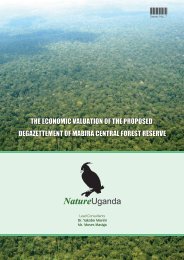A Ecological Baseline Surveys Of: - Lake Bisina - Nature Uganda
A Ecological Baseline Surveys Of: - Lake Bisina - Nature Uganda
A Ecological Baseline Surveys Of: - Lake Bisina - Nature Uganda
You also want an ePaper? Increase the reach of your titles
YUMPU automatically turns print PDFs into web optimized ePapers that Google loves.
Quadrats: Nested quadrats of standard sizes (trees 30 x 30 m, shrubs 15 x 15 m and herbs 2 x 2<br />
m) were laid along these transects at an interval of 20m. Opportunistic sampling (visual estimates<br />
with out plotting) was applied on micro habitats that lay outside the quadrats in order to capture as<br />
much data as possible. The checklist generated will be used to set the ecological standards that<br />
shall be used as the bench mark for future references.<br />
Percentage cover: Percentage cover estimations were visual characterized under three strata<br />
(layers) levels (trees, shrubs and herbs). All species encountered were recorded. The unidentified<br />
species in the field were collected, given a unique reference number and taken to Makerere University<br />
Herbarium (MHU) for identification.<br />
4.1.7 Results<br />
A total of 123 species from 94 genera and 43 families were recorded. <strong>Of</strong> these, 16 were trees, 21<br />
shrubs and 86 herbaceous species. Poaceae was the most represented family with 16 species,<br />
followed by Asteraceae with 14 (Appendix 1).<br />
4.1.7.1 Species abundance<br />
Species abundances were visually estimated as percentage cover values per quadrat following the<br />
scale of 80-100 =5, 60- 79 =4, 40- 59 =3, 20- 39 =2, 1- 19 = 1 and below 1 =+.<br />
The herbal layer consists mainly of tall Cyperus papyrus, Echinochloa pyramidalis, and several<br />
woody seedlings constituting to about 80 % of the plant cover while the shrub and tree layers both<br />
constitute about 10 % and bare ground about 10 %. For all sampled quadrats, species’ average<br />
cover values were calculated and are presented in Table 1 (Please note that a species may occur in<br />
more than one stratum or layer).<br />
Table 1: Species abundance<br />
Layer Family Species % cover Life form<br />
Tree<br />
Anacardiaceae Rhus natalensis 1 P<br />
Asteraceae Pluchea ovalifolia 5 P<br />
Asteraceae Vernonia amygdalina 1 P<br />
Caesalpiniaceae Sesbania sesban 1 P<br />
Capparaceae Capparis tomentosa 2 P<br />
Convolvulaceae Ipomoea wightii 1 P<br />
Cyperaceae Cyperus dives 1 P<br />
Cyperaceae Cyperus papyrus 5 P<br />
Ebenaceae Euclea tridens 1 P<br />
Euphorbiaceae Flueggea virosa 1 P<br />
Euphorbiaceae Spondianthus preusii 2 P<br />
Lauraceae Beilschmiedia ugandensis 1 P<br />
Menispermaceae Cissampelos mucronata 1 P<br />
Mimosaceae Acacia kirkii 1 P<br />
Mimosaceae Acacia polyacantha 4 P<br />
Mimosaceae Acacia sieberiana 2 P<br />
56<br />
<strong>Ecological</strong> <strong>Baseline</strong> <strong>Surveys</strong> of <strong>Lake</strong> <strong>Bisina</strong>, <strong>Lake</strong> Opeta, <strong>Lake</strong> Mburo and Nakivali Wetlands Systems



